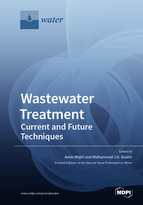Wastewater Treatment: Current and Future Techniques
A special issue of Water (ISSN 2073-4441). This special issue belongs to the section "Wastewater Treatment and Reuse".
Deadline for manuscript submissions: closed (31 December 2021) | Viewed by 98019
Special Issue Editors
Interests: waste management; wastewater treatment; water quality engineering; water treatment; anammox
Special Issues, Collections and Topics in MDPI journals
Interests: water and wastewater treatment; emerging contaminants, waste management technology; water energy nexus; bioenergy; pollution control
Special Issues, Collections and Topics in MDPI journals
Special Issue Information
Dear Colleagues,
Several countries are thereatend by severe clean water shortages due to the impacts of climate change, rapid urbanisation and population growth, and environmental pollution; therefore, using treated wastewater can be considered as an applicable way to overcome the water shortage problems. Day by day, international/national effluent standards become tighter and tighter, posing a remarkable challenge in the water industry. Consequently, treatment methods with maximum performance and minimum energy consumption are urgently demanded for wastewater and water treatment. This Special Issue of Water on “Wastewater Treatment; Current and Future Techniques” seeks original research and review manuscripts on advanced technologies applied to the treatment of inductrial and domestic wastewater, and sludge. We would like to invite you to submit your valuable original research and review manuscripts in this Special Issue and share new findings on wastewater treatment.
Assist. Prof. Dr. Amin Mojiri
Assoc. Prof. Dr. Mohammed J.K. Bashir
Guest Editors
Manuscript Submission Information
Manuscripts should be submitted online at www.mdpi.com by registering and logging in to this website. Once you are registered, click here to go to the submission form. Manuscripts can be submitted until the deadline. All submissions that pass pre-check are peer-reviewed. Accepted papers will be published continuously in the journal (as soon as accepted) and will be listed together on the special issue website. Research articles, review articles as well as short communications are invited. For planned papers, a title and short abstract (about 100 words) can be sent to the Editorial Office for announcement on this website.
Submitted manuscripts should not have been published previously, nor be under consideration for publication elsewhere (except conference proceedings papers). All manuscripts are thoroughly refereed through a single-blind peer-review process. A guide for authors and other relevant information for submission of manuscripts is available on the Instructions for Authors page. Water is an international peer-reviewed open access semimonthly journal published by MDPI.
Please visit the Instructions for Authors page before submitting a manuscript. The Article Processing Charge (APC) for publication in this open access journal is 2600 CHF (Swiss Francs). Submitted papers should be well formatted and use good English. Authors may use MDPI's English editing service prior to publication or during author revisions.
Keywords
- Wastewater treatment technologies
- Resource recovery from wastewater
- Sludge reduction processes
- Water energy nexus
- Removal of emerging micropollutants
- Tertiary treatment technologies
- Anammox







